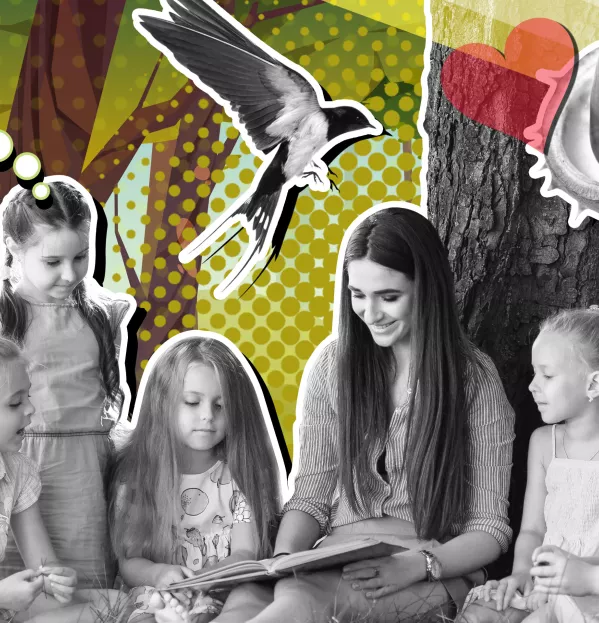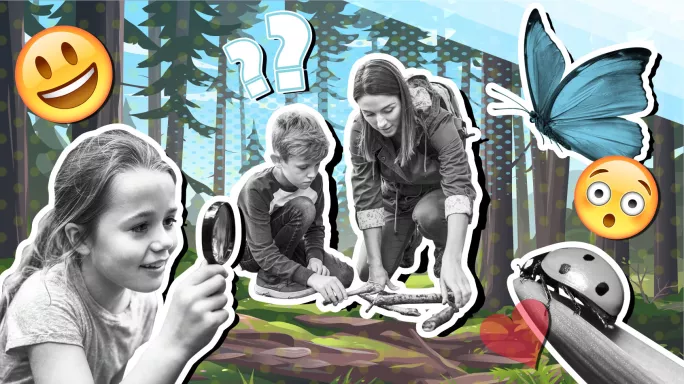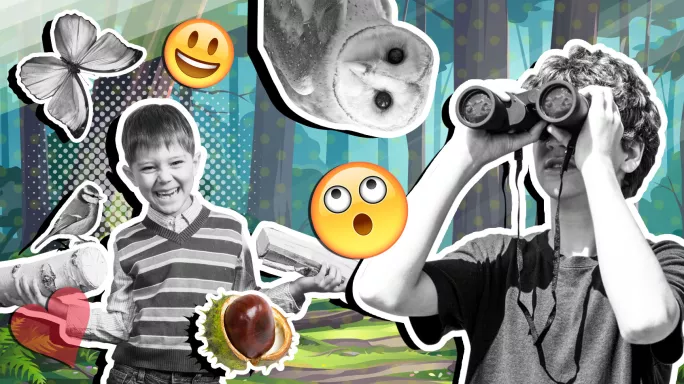- Home
- Teaching & Learning
- Primary
- Why we may be getting outdoor education (very) wrong
Why we may be getting outdoor education (very) wrong

There is a stereotypical image that comes to mind when one hears the phrase “outdoor learning”. It’s an idyllic picture: small children in coats and wellies, sitting around a bonfire, engaged in some kind of traditional craft, such as whittling sticks or weaving baskets.
This image stems, largely, from the forest school movement. Imported from Scandinavia in the 1990s, it has since exploded in popularity; there are now more than 200 certified forest schools in the UK, and they are reportedly experiencing a surge in demand in the wake of the pandemic.
It’s not hard to see why the movement, with its emphasis on the Scandinavian open-air culture friluftsliv - or “free air life” - has taken off so spectacularly.
According to the Forest School Association, forest school is a long-term, child-centred programme that “develops confidence and self-esteem through learner-inspired, hands-on experiences in a natural setting”. It involves children and young people taking part in outdoor activities that support “play, exploration and supported risk taking” in regular sessions led by accredited practitioners.
- Teaching and learning: “Outdoor learning has improved our pupils’ attainment”
- Outdoor learning: Five ways to focus on it throughout primary school
- Forest schools: How to make forest schools work in cities
But forest school is just one approach to outdoor learning. And there are those who worry that this way of doing things could be overshadowing other, more traditional approaches.
So, what do we really know about what works when it comes to outdoor learning?
In 2015, a huge analysis of outdoor learning in the UK, conducted by researchers from the UCL Institute of Education and the Evidence for Policy and Practice Information and Co-ordinating Centre (EPPI-Centre), aimed to answer this question.
The study found that “almost all outdoor learning interventions had a positive effect” and that longer-term projects appear to bring greater benefits as “the effect attenuates over time”.
The advantages of outdoor learning
Dr Sara Collins, forest school practitioner and deputy chair of the Forest Schools Association, has seen this effect for herself. She says that children benefit from taking part in the forest schools programme.
“[Children] are learning how to manage their risk and learn how to keep themselves safe. They are reconnecting with nature, seeing the seasons change, becoming familiar with immediate surroundings and understanding how they fit into the world,” she explains.
“It’s child-led and there’s a level of risk that’s challenging the children… It’s a learning experience, but it’s not curriculum-led; it’s following the curiosity of the children and so, because of that, they can really benefit from it.”
Those benefits aren’t just academic. There is evidence that spending time outdoors can boost young people’s wellbeing. In a recent government-backed survey, published in 2021, 85 per cent of eight- to 15-year-olds surveyed reported that being in nature made them “very happy”.
How secure is the evidence for those benefits, though?
Gemma Goldenberg is currently working on a PhD on the impact of nature on children’s cognition, behaviour and wellbeing at the University of East London. She says that the research picture around what good outdoor learning looks like is still quite unclear, and that the notion that forest school is somehow superior to other outdoor learning approaches is just not supported by evidence.
“No research proves that forest school is any more beneficial than any other type of outdoor learning”
“There’s plenty of research that shows that outdoor learning is a good thing for children’s development. And there’s quite a lot of qualitative research that shows that it’s good for children’s self-confidence and their physical activity and all of that,” she explains.
However, there is a problem with many of the existing studies in that “they don’t tend to have any control groups”.
“If you take a group of children and give them any intervention, really, they’re likely to have some positive effects from it,” Goldenberg explains.
“[But] there’s not any study that says, ‘OK, we’ll give this class of children forest school, we’ll give this class of children another type of outdoor learning, and we’ll give this class of children nothing, and then we’ll compare.’
“That would be the best way for us to see what the effects are, but there just isn’t any research like that. A lot of it is quite woolly.”
For instance, she says, in one study, forest school was shown to help build stamina in three- and four-year-olds. After six months of the programme, children were able to walk a mile to the forest school site without complaining of fatigue, whereas, previously, this had made them really tired.
But, Goldenberg points out, three- and four-year-olds will naturally become more advanced in their physical development over the course of six months, regardless of any intervention.
“They just got older and would have gotten stronger and fitter anyway,” she says. “That sort of thing is often quite overlooked in research.”
In short, she explains, there is “basically no research that proves that forest school [or any other similar programme] is any more beneficial than any other type of outdoor learning”.
Dr Helen Bilton agrees that forest school has an unwarranted precedence in UK schools. Worse, she says, it has led - unintentionally - to poor practice around outdoor learning.

Bilton is a professor of outdoor learning at the University of Reading and an author of numerous books on the topic, including the seminal Outdoor Learning in the Early Years: management and innovation, which was released in third edition in 2010.
She is a great believer in the idea that “any part of the curriculum can be taught and learned outside” - and that you don’t need a dedicated programme for pupils to see the benefits.
This, Bilton says, is something that we have lost sight of in recent years. Since the 1990s, there has been a “narrowing of education”, coupled with a rise in “liability culture”, that has made staff more reluctant to take learning outside.
“With my books on outdoor play, I’ve had to hammer home that the Health and Safety Executive, RoSPA [The Royal Society for the Prevention of Accidents], they’re all saying, ‘It isn’t us saying that you can’t play with conkers outside!’ It’s teachers who have panicked, and headteachers got fearful. So into the void came things like forest school, which seems like an answer to liability culture because if anything goes wrong, it’s their problem,” says Bilton.
This has led to questionable perceptions about what “outdoor learning” can be.
“[Some of the programmes] I’ve seen are just dreadful,” she says. “Children in lines or all sat around a fire. Children with tabards on, very controlled; which is possibly why they do that, because they are worried about the risk assessment. It is quite formulaic.”
Forest schools: can we see the wood for the trees?
So not only do we need more evidence about outdoor learning in general, we clearly also need more research around the types of outdoor learning being used in UK schools and that might be more effective.
Goldenberg says that to do this research effectively, we need to reset our expectations of outdoor learning. Teachers and leaders now think that outdoor learning “needs to be a specific approach or they need specific training to do it”.
What’s more, she says, she has anecdotally heard of schools being advised to have forest school-trained practitioners in order to take children outside, for insurance purposes.
And that training comes at a cost: staff can become forest school practitioners or leaders by undertaking courses at level 1 (30 hours, around £250), level 2 (70 hours, between £300 and £500) and level 3 (180 hours, between £500 and £900).
Collins, however, says training in this area is designed to improve staff confidence in leading outdoor activities, not make them more nervous about it.
“When I started out, the thought of children sawing a piece of wood or lighting a fire made me nervous, but the benefit of training is that you have an understanding about how to have a good risk assessment and dynamically assess risk as well,” she explains.
“So, for me, it was reassuring that I’d thought things through. You can’t necessarily predict what’s going to happen, but it’s having that confidence that you’re qualified in first aid and you have all the policies and procedures in place.”
“It’s just children learning outside. It’s no more complicated than that”
But while safety is, of course, important, Bilton worries that recent trends for activities such as cooking over campfires mean teachers now assume that if there isn’t a carefully managed element of risk involved, they aren’t doing outdoor learning properly.
Instead, she says, schools need to get back to basics: “We need to take the industry out of it. It’s just children learning outside. It’s no more complicated than that.”
So, if schools aren’t going to buy in a special programme, or train their staff to deliver one, how can they make sure that pupils are getting the most out of outdoor learning?
Bilton suggests that there are a number of ways for schools to do outdoor learning well. This might involve pupils getting their hands dirty and engaging with the natural environment, but it can also just mean children “sitting outside and doing more formal work or being told a story”.
Regardless of the activity, she says, “outdoor learning is different to indoor learning because it is a holistic experience, mind and body, and it helps learning to stick”.
This idea is the focus of Goldenberg’s current research: she is trying to find out whether the very act of moving a lesson outside can bring benefits. So, she is taking desks, chairs, rugs, reading corners and so on and putting them outdoors, with the teachers using the same resources and lessons as they would inside.
Half of the session takes place outside and half inside, and the students are monitored throughout, with head-mounted cameras, so Goldenberg can check attention (“How much time did they spend looking at the teacher when she’s teaching compared to staring into space?”), and heart-rate monitors, to track stress levels.

“I just finished a four-week block in a school and we haven’t done the analysis yet, but anecdotally, the teacher has said she thinks the children are much calmer outside,” she says.
“There’s quite a lot of research that says natural stimuli are a lot less distracting. It’s just easier for us to visually process natural scenes because there’s less colour variation and edges are very soft. Those natural environments tend to flip our brains into more of a rest mode, which allows us then to pay attention to the things that we really need to.”
Children are ‘much calmer’ when learning outside
This is in stark contrast, she continues, to the often busy classroom environment, with lots of bright visuals on the walls and noise from other students or classrooms.
“Some of the children with special needs are talking a lot more outside,” Goldenberg says. “There’s quite a lot of research about background noise in classrooms as well; that it’s particularly detrimental for younger children, but especially children with any kind of speech and language delay.”
When you’re outside, she explains, you don’t have echoes bouncing off surfaces so much, and background noise tends to get carried away on the breeze a bit more.
“We think that might be encouraging, especially some of the less verbal children and the autistic children, to communicate more with their peers when they’re outside.”
Researchers have also identified positive effects for children with attention deficit hyperactivity disorder (ADHD). A 2009 study from the University of Illinois reported that “20 minutes in a park setting was sufficient to elevate attention performance” and that “‘doses of nature’ might serve as a safe, inexpensive, widely accessible new tool in the tool kit for managing ADHD symptoms”.
There is also research to suggest that, against many teachers’ instincts, children are generally calmer and better able to concentrate when they’re back in the classroom after a stint outside.
A 2018 study found that “far from leaving students too keyed up to concentrate afterward, lessons in nature may actually leave students more able to engage in the next lesson, even as students are also learning the material at hand”.
The researchers concluded that these findings make the case for “including more lessons in nature in formal education”.
All of this is not to say that there is no place for the more adventurous outdoor activities like forest school, but simply that they aren’t always necessary to make an impact: just taking a standard lesson outside can still be beneficial.
We need more research about this whole area as it grows in prominence, but in the meantime the researchers believe teacher knowledge about what good learning looks like will ensure that whatever they do has impact, wherever they do it.
“Good-quality outdoor learning doesn’t have to be big, it doesn’t have to be small - you’ve just got to use the space you’ve got,” says Bilton.
Zofia Niemtus is a freelance journalist
You need a Tes subscription to read this article
Subscribe now to read this article and get other subscriber-only content:
- Unlimited access to all Tes magazine content
- Exclusive subscriber-only stories
- Award-winning email newsletters
Already a subscriber? Log in
You need a subscription to read this article
Subscribe now to read this article and get other subscriber-only content, including:
- Unlimited access to all Tes magazine content
- Exclusive subscriber-only stories
- Award-winning email newsletters
topics in this article



